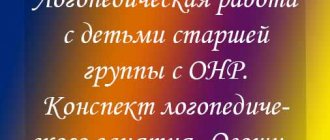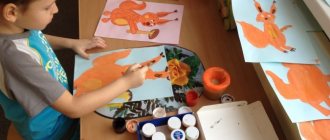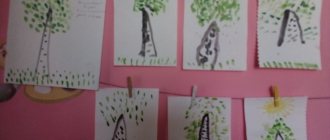Summary of the final lesson for children of the middle group on the topic: “Journey through the seasons”
Author: Belikova Vera Aleksandrovna, teacher of the MKDOU “Kalacheevsky kindergarten No. 1 of a general developmental type”
Explanatory note to the author's material
This lesson is intended for kindergarten teachers. Applies to the areas: “Knowledge”, “Communication”, “Creativity”. With the help of this lesson, children will consolidate their acquired knowledge about the natural world around them in an entertaining and playful way, learn to analyze, compare, make generalizations, and establish simple cause-and-effect relationships. The notes will help to conduct interesting activities that are developmental in nature and include various types of child activities. Promotes the formation of speech, memory, logical attention.
Summary of the final lesson for children of the middle group on the topic: “Journey through the seasons.”
Technological map of organized educational activities
Age group: secondary Educational areas: “Cognition”, “Communication”, “Creativity”. Section: Familiarization with the surrounding world. Topic: “Journey through the seasons.” Program objectives: 1. Educational: – the ability to perceive the image of each season; – enrich your vocabulary; – consolidate knowledge about wintering and migratory birds; – consolidate the ability to close a line into a ring and paint, repeating the outlines of the drawn figure. 2.Developing: – develop observation, interest in the surrounding nature, activity, attentiveness, reasoning skills; – develop an aesthetic perception of the beauty of nature; – develop creative imagination, ingenuity, ingenuity, fantasy and logical thinking. 3. Educational: – cultivate a love of nature; – bring children joy and pleasure from games; – cultivate the ability to listen carefully to the stories of your comrades and complement the answers. Preliminary work: memorizing poems, signs, proverbs about different seasons, looking at pictures about the seasons, observing on the street, on the site during walks throughout the year, drawing all the seasons. Vocabulary work: to activate in children’s speech words that characterize the seasons.
Progress of the lesson: 1. Motivational and incentive stage: Our ears are on top of our heads. The eyes are wide open. We listen, we remember, we don’t waste a minute. Guys, I have a magic scarf in my hands, with the help of it you can take a fascinating journey through the “Seasons”, you just have to cover all of you with this scarf. Do you want to go on an interesting and educational journey that will help us remember and compare all the seasons? 2. Organizational - search stage: (I cover the children with a scarf) The sound of transformation. - So, the journey begins, and you have to guess what time of year we are in. The melody “Sounds of Nature” plays. Snowstorm". – What time of year do you think we can hear such sounds outside the window? (if the children do not guess by sound, I give a hint, a riddle). I dusted the paths and decorated the windows. She gave joy to the children and gave them a sledding ride. (I take off my scarf and offer to sit at the tables) - That’s right, it’s winter, only at this time of year the blizzard howls outside the window. – Who can tell us how winter differs from other seasons? Let’s remember the signs of winter. Slide No. 1 A bear in a den, a squirrel in a hollow, a hedgehog under a stump, a hare. (with a click, a hollow, a snowdrift, a stump disappear) - The snow covered the whole earth with a white blanket and many animals hid under it from the frost. Look, there is a door on the tree here, I wonder who is hiding behind it? How do you think? - Let's check. That's right, the squirrel, she stocked up on nuts and mushrooms in advance and can now safely spend the winter in the hollow. But the snowdrift is also unusual, it’s probably someone’s house too? – What is the name of the bear’s house? -Who was hiding under the stump? - Yes, it's a hedgehog. He curled up and got ready to sleep. - And the hare, who runs through the forests and fields in winter, was given a new coat by winter. Who remembers which one? That's right - white. - Why does the bunny need a white fur coat? - Yes, guys, you can’t see him in the snow. (I suggest turning the chairs towards the table, I draw attention to the illustrations with birds lying in front of the children) - With the arrival of winter, life is hard for the birds. Not all of them stay with us for the winter. Name those birds that fly to warmer climes. - And now those birds that remain for the winter. - Everyone coped with the task, well done. The melody “Sounds of Nature” plays. A babbling stream." - Guys, you hear these sounds, it’s winter being replaced by another season. Loose snow melts in the sun, The wind plays in the branches, Birds' voices are louder, So it has come to us... Slide No. 2 (children make up a descriptive story using the pictures) - Let's make a short descriptive story about spring using the pictures? – That’s right, all nature comes to life in the spring. Everything around is green and singing. In the spring chaos, domestic animals have lost their cubs and cannot be found. Please come to me, let's help the kids, let's find their mothers. (children on the magnetic board make up pairs of animals and their babies) - Well done, guys. Not only birds, animals, and insects rejoice in spring, because all nature comes to life. Let's liven things up a little. Physical education To the song of the Barbarika group “The Little Animals Cried.” Jumping, jumping in the woods Gray balls of hares Jump-jump, jump-jump The little bunny stood on a stump He lined everyone up in order and began to show exercises. Once! Everyone walks in place. Two! They wave their hands together. Three! They sat down and stood up together. Everyone scratched behind the ear. We reached four. Five! They bent over and bent over. Six! Everyone stood in a row again, They walked like a squad. The melody “Sounds of Nature” plays. Birds singing” – After spring comes the next season. The sun is shining, the flowers are blooming, the berries are ripening, when does this happen? -Who can name this time of year? That's right - summer. – What changes occur in nature with the arrival of summer? Slide No. 3 Fruits - Correct. Summer brings us a lot of berries, vegetables and fruits. What are these guys? (pointing to the apple) What is it? It's red. And what's that? (pointing to the pear) this is a pear. Pear, what color? She's yellow. Where do fruits grow? – Look how many vegetables and fruits there are. Who will tell me all the fruits, and who will list the vegetables. – Why didn’t you name cherries, raspberries, strawberries, plums? - That's right, because they are berries. - Let's move on. I walked through the meadows, through the forests, through the fields. She prepared supplies for us, hid them in cellars, in bins, and said: Winter will come for me. - Of course it’s autumn. I suggest you remember the signs of autumn. – Look, my artist friend sent us illustrations of autumn, is everything on them correct? Slide No. 4 (Didactic game “What did the artist mix up?”) - And guys, your mothers make supplies for the winter in the fall, pickle cucumbers and tomatoes. Let's help mothers too. Sit down at the tables, let's draw tomatoes in a jar with a red lid, and cucumbers in a jar with a green lid. – What shape does a tomato have and a cucumber? – What color paint will we use when painting tomatoes and cucumbers? (children use cotton swabs to draw the outline of vegetables, then paint, repeating the outline of the drawn figure). - Well done guys, you all coped with the task. 3. Reflective - corrective stage: Well, our journey has ended. – What did you like most? – I really enjoyed traveling with you, today you were active, attentive, and smart. You have once again proven that you know a lot about the nature around you. Well done! -Well, in order for us to be in the group again, I need to cover all of you with a scarf. The melody of transformation sounds. - Well, here we are at home. Once again I want to thank you for such an interesting time spent with you.
Literature used: O.S. Ushakova, E.M. Strunina “Speech development in children 4-5 years old” Moscow 2007. A.A. Gribovskaya “Lesson in visual arts” Moscow 2009. I.A. Lykova “Fine arts in kindergarten. Middle group" Moscow 2010. T.N. Doronova “Visual activity and aesthetic development of a preschool child” Moscow 2006. . 9. A.A. Gribovskaya “Collective creativity of preschool children” Lesson notes Moscow 2004.
Project at preschool educational institution. Seasons. Middle group
Formulation of the problem
Children show little cognitive interest in directly perceived objects and are not interested in what they previously saw, heard, or learned. Basically, they observe their surroundings with little interest and need the help of an adult to generalize the results of observations. In the process of learning, they do not show a sense of surprise, do not rejoice at the new; and only under the guidance of an adult are involved in carrying out research tasks. Parents of children also pay little attention to observing objects and natural phenomena. They do not pay attention to the incorrect attitude of children towards objects of nature, they do not involve children in joint work in nature
Implementation deadlines
: October - May.
Project participants
: children of the middle group, parents of students, group teacher: Yanaki O.E.
Objective of the project:
To form in children of middle preschool age holistic ideas about the seasons.
Tasks:
1. To form in children a cognitive interest in the world around them and their native nature.
2. Introduce children to the characteristic features of each season.
3. Develop the creative abilities of each child by developing practical skills in children in the development of coherent speech and other mental functions, using various types of activities.
4. Arouse the need to treat nature carefully and carefully, developing observation and interest in the environment, the ability to see beauty at different times of the year.
Project implementation stages
1. Preparatory (September) - Creation of a developmental environment - Questioning parents - Selection of methodological literature - Selection of fiction and educational games - Card index of finger and outdoor games - Materials for experimentation
2. Practical (from October 1 to May 15) Organization of children’s activities
3. Final (May 15-May 31) Determining the result of practical activities with children
Forms of work:
— GCD — Didactic games — Outdoor games — Finger games — Speech games — Observations in nature — Work in nature — Experimental activities — Productive activities — Reading fiction — Musical and rhythmic movements, listening to music
Expected results:
— Ideas about the seasons have been formed.
-An idea about the work of adults at different times of the year has been formed.
— Ideas about the correct ways to interact with natural objects have been formed.
— Developed interest in observing objects and natural phenomena and caring for them.
— The level of environmental education of parents has increased.
Project implementation plan
:
October November
| Conversations | Artist creation | Reading fiction, memorizing | Did.games | Listening to music | Entertainment | Interaction with family |
| 1. “How nature paints with colors”, examination of illustrations by artists: I. Shishkin, I. Levitan, I. Grabar, K. Yuon, K. Korovin, P. Trubetskoy. 2. “Why is autumn called golden”; 3. “Where and why do birds fly away”; 4. “What does autumn give us? " 5. Examination of the herbarium. | Drawing on the theme: “Colors of Autumn”, “Autumn Forest”, using the non-traditional technique “frottage”. Applications from dry leaves | V. Bianchi “Spider-Pilot”; E. Uspensky “How cabbage was grown”; E. Blaginina “They are flying away, flying away. ", "Autumn"; E. Mashkovskaya “It’s time for winter”; Mike "Autumn" A. Block “Bunny”; G. Skrebitsky “Forest Voice”; N. Sladkoe “Why is November piebald”, “Forest rustles”, “Powder”;, “Swifts”; V. Zotov “Forest Mosaic” (stories about wild animals). Memorization: A. Maikov “Landscape”; E. Mashkovskaya “Autumn”. | “Seasons”, “When this happens”, “Fold the picture”, “Such a leaf, fly to me”, “What tree is the leaf from”, “Don’t be mistaken”, “Run to the tree”. Goal: to develop children’s ingenuity, intelligence, and consolidate children’s knowledge about the seasons. | A. Vivaldi “Autumn” from the cycle “The Seasons”. P. Tchaikovsky: “Autumn Song”, “October”. | 1.Musical entertainment “Autumn Festival”. 2. Autumn Birthday Festival | Involve parents in making crafts from natural materials and creating an “Autumn” album. |
| December–February | ||||||
| Conversations | Artistic creativity | Reading literature, memorization | Did. games | Listening to music | Entertainment | Interaction with family |
| 1. Tour of the winter city. 2. Acquaintance with art - examination of reproductions of paintings on the theme “Winter”: K. Yuon “Russian Winter”, I. Shishkin “Pine”, I. Grabar “February Azure”. 3. “How to help birds in winter?”; 4. “What is the plant sad about?”; 5. “Why don’t people freeze in winter? "; 6. “How do animals live in winter?” | Drawing on the topic: “My magical snowflakes” (candle and watercolor), “First snow” (finger painting, signet printing); “I’m in a magical forest” (drawing with different materials using non-traditional techniques) | Y. Akim “First Snow”; E. Trutneva “First Snow”, “Christmas Tree”; E. Uspensky “The Mischief of the Old Woman of Winter”; V. Kalinin “About the snow bun”; V. Charushin “What kind of animal? "; L. Charskaya “Winter”; N. Rubtsov “Crow”; “Feed the birds in winter”; A. Klykov “Squirrel”, “How a fox winters”; V. Pokrovsky “Wolf”, “Bear”; N. Pozharitskaya “Journey to Pets.” Memorization: I. Demyanova “Sparrow”, Russian folk nursery rhyme “Like thin ice”. | “Seasons”, “Find out by description”, “Dress Mashenka”, a mystery story about various objects and natural phenomena. Goal: to develop attention and intelligence. | P. Tchaikovsky “December – Christmastide” “Seasons”. V. Shainsky “Snowflakes”, A. Vnukova “If it snows.” Singing and listening to songs about winter. | 1. New Year's party 2. Winter birthday party. 3. Sports entertainment on the street “Prankster Winter” | Involve parents in designing an album with children’s works and photographs on the theme “Winter” Making paintings using the “testoplasty” technique on a winter theme. Learning poems with children about winter. |
| March-May | ||||||
| Conversations | Artistic creativity | Reading literature, memorization | Did. games | Listening to music | Entertainment | Interaction with family |
| 1. “Who wakes up in the spring? "; 2. “What does a mother teach her kids? "; 3. “What did you see unusual on the way to kindergarten? "; 4. conversation about flowers, looking at illustrations of primroses. 5.Looking at photographs and postcards about spring. | Application: “Branch with the first leaves,” “Spring bouquet” (use of various materials) Drawing: “Birch trees in spring,” “Dandelions” (non-traditional drawing techniques) | L. Tolstoy “Spring has come”, “How wolves teach their children”; G. Skrebitsky “In a forest clearing”; N. Sladkoe “Spring Joys”; V. Alferov “March”; V. Zotov “White Hare”, “Hedgehog”, “Chipmunk”, “Wolf”, “Squirrel”; V. Bianki “Forest Newspaper” - S Ak-ti-pa “Gnmpl”, L. Akim “April”; I. Belyakov “Snowdrop woke up”; K. Ushinsky “Bees on reconnaissance”; G. Silver “Happy Bug”; V. Stepanov “Flying Flower”; E. Serova “Lily of the Valley”, “Violet”; E. Charushin “Sparrow”. Memorization: S. Marshak “Spring Song”; M. Klokova “Winter has passed”, Nar. choruses about spring. | "Seasons". Goal: to consolidate children’s ideas about the sequence (cyclicity) of changes in nature in spring, summer, winter, and autumn according to essential features. | Listening to the Russian folk song “Kulik - Spring”, N. Lyubarsky “Rain”, P. Tchaikovsky “Seasons”, W. Mozart “Spring”. | 1. Spring birthday party. 2. Holiday for March 8th. 3. Entertainment “Maslenitsa” | Involve parents in designing an album with children's works and photographs on the theme “Spring”. Making an information stand for parents. Involve parents in the selection of waste and natural materials. |
Questionnaire for parents
“Environmental education in the family” The purpose of the survey
: to identify the attitude of parents to the issues of environmental education of preschool children in kindergarten and its actual implementation in the family. 1. Do you have animals at home? (Cat, fish, dog, hamster, etc.) 2. Are there any indoor plants? Which? 3. Who cares for animals or plants? 4. What does the child do (feed him, walk him, play, water him, or do nothing)? – Underline or add. 5. Do you go outdoors with your child? If yes, where? 6. For what purpose? 7. Where does the child usually spend the summer? 8. How do you feel about introducing a child to nature in kindergarten? 9. Your suggestions for organizing environmental education in kindergarten.
Bibliography:
1. Voronkevich O.A. “Welcome to ecology” (Methodological manual). 2. Babaeva T.I. Gogoberidze A.G. Loginova V.I. Mikhailova Z.A. and others. Childhood. Sample basic general education program for preschool education. Redesigned to meet federal government requirements. 3. Internet resources.
Application



